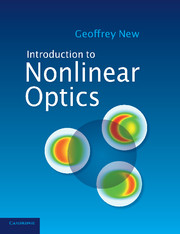Book contents
- Frontmatter
- Contents
- Preface
- Acknowledgements
- 1 Introduction
- 2 Frequency mixing
- 3 Crystal optics
- 4 Nonlinear optics in crystals
- 5 Third-order nonlinear processes
- 6 Dispersion and optical pulses
- 7 Nonlinear optics with pulses
- 8 Some quantum mechanics
- 9 Resonant effects
- 10 High harmonic generation
- Appendix A Conventions and units
- Appendix B Linear and nonlinear susceptibilities in the time and frequency domains
- Appendix C Definition of the nonlinear coefficients
- Appendix D Non-zero d elements in non-centrosymmetric crystals
- Appendix E Real fields, complex fields, and the analytic signal
- Appendix F Geometry of the grating pair
- Appendix G The paraxial wave equation
- Appendix H Useful formulae for numerical simulations
- Appendix I Useful constants
- Answers to problems
- Further Reading
- References
- Index
10 - High harmonic generation
Published online by Cambridge University Press: 05 June 2012
- Frontmatter
- Contents
- Preface
- Acknowledgements
- 1 Introduction
- 2 Frequency mixing
- 3 Crystal optics
- 4 Nonlinear optics in crystals
- 5 Third-order nonlinear processes
- 6 Dispersion and optical pulses
- 7 Nonlinear optics with pulses
- 8 Some quantum mechanics
- 9 Resonant effects
- 10 High harmonic generation
- Appendix A Conventions and units
- Appendix B Linear and nonlinear susceptibilities in the time and frequency domains
- Appendix C Definition of the nonlinear coefficients
- Appendix D Non-zero d elements in non-centrosymmetric crystals
- Appendix E Real fields, complex fields, and the analytic signal
- Appendix F Geometry of the grating pair
- Appendix G The paraxial wave equation
- Appendix H Useful formulae for numerical simulations
- Appendix I Useful constants
- Answers to problems
- Further Reading
- References
- Index
Summary
Introduction to high harmonic generation
The treatment of frequency mixing in the early chapters of this book was based on the assumption that the applied EM fields were weak compared to the internal fields within the nonlinear media. This enabled the polarisation to be expanded as a power series in the field, and perturbation theory to be used to calculate the nonlinear coefficients.
In this chapter, we consider the generation of optical harmonics in the strong-field regime, where the fields are sufficiently intense to ionise the atoms in a gaseous medium, and the electrons released then move freely in the field, at least to a good approximation. As we shall discover, an enormous number of harmonics can be generated in these circumstances, extending across a broad spectral plateau that extends deep into the soft X-ray region. High harmonic generation (HHG) therefore creates a table-top source of coherent X-rays, which has already been applied in lensless diffraction imaging [107]. Moreover, if the huge spectral bandwidth is suitably organised, HHG enables pulses as short as 100 attoseconds or even less to be generated [108]. These can then serve as diagnostic tools on unprecedented time-scales. They have already been used to probe proton dynamics in molecules with a 100-as time resolution [109], and to measure the time delay of electron emission in the photoelectric effect for the first time [110]. Other applications are described in [111].
- Type
- Chapter
- Information
- Introduction to Nonlinear Optics , pp. 204 - 217Publisher: Cambridge University PressPrint publication year: 2011



